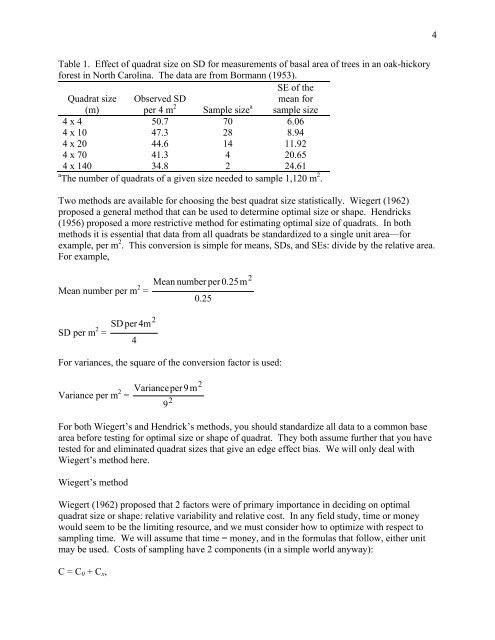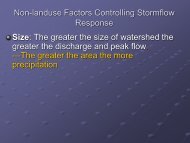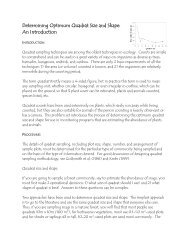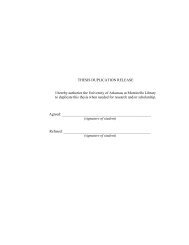An Introduction to Determining Optimum Quadrat Size and Shape
An Introduction to Determining Optimum Quadrat Size and Shape
An Introduction to Determining Optimum Quadrat Size and Shape
Create successful ePaper yourself
Turn your PDF publications into a flip-book with our unique Google optimized e-Paper software.
Table 1. Effect of quadrat size on SD for measurements of basal area of trees in an oak-hickory<br />
forest in North Carolina. The data are from Bormann (1953).<br />
<strong>Quadrat</strong> size Observed SD<br />
(m) per 4 m 2<br />
Sample size a<br />
SE of the<br />
mean for<br />
sample size<br />
4 x 4 50.7 70 6.06<br />
4 x 10 47.3 28 8.94<br />
4 x 20 44.6 14 11.92<br />
4 x 70 41.3 4 20.65<br />
4 x 140 34.8 2 24.61<br />
a 2<br />
The number of quadrats of a given size needed <strong>to</strong> sample 1,120 m .<br />
Two methods are available for choosing the best quadrat size statistically. Wiegert (1962)<br />
proposed a general method that can be used <strong>to</strong> determine optimal size or shape. Hendricks<br />
(1956) proposed a more restrictive method for estimating optimal size of quadrats. In both<br />
methods it is essential that data from all quadrats be st<strong>and</strong>ardized <strong>to</strong> a single unit area—for<br />
example, per m 2 . This conversion is simple for means, SDs, <strong>and</strong> SEs: divide by the relative area.<br />
For example,<br />
Mean number per m 2 2<br />
Mean number per 0.25m<br />
=<br />
0.25<br />
SD per m 2 2<br />
SD per 4m<br />
=<br />
4<br />
For variances, the square of the conversion fac<strong>to</strong>r is used:<br />
Variance per m 2 =<br />
2<br />
Varianceper<br />
9 m<br />
2<br />
9<br />
For both Wiegert’s <strong>and</strong> Hendrick’s methods, you should st<strong>and</strong>ardize all data <strong>to</strong> a common base<br />
area before testing for optimal size or shape of quadrat. They both assume further that you have<br />
tested for <strong>and</strong> eliminated quadrat sizes that give an edge effect bias. We will only deal with<br />
Wiegert’s method here.<br />
Wiegert’s method<br />
Wiegert (1962) proposed that 2 fac<strong>to</strong>rs were of primary importance in deciding on optimal<br />
quadrat size or shape: relative variability <strong>and</strong> relative cost. In any field study, time or money<br />
would seem <strong>to</strong> be the limiting resource, <strong>and</strong> we must consider how <strong>to</strong> optimize with respect <strong>to</strong><br />
sampling time. We will assume that time = money, <strong>and</strong> in the formulas that follow, either unit<br />
may be used. Costs of sampling have 2 components (in a simple world anyway):<br />
C = C0 + Cx,<br />
4






